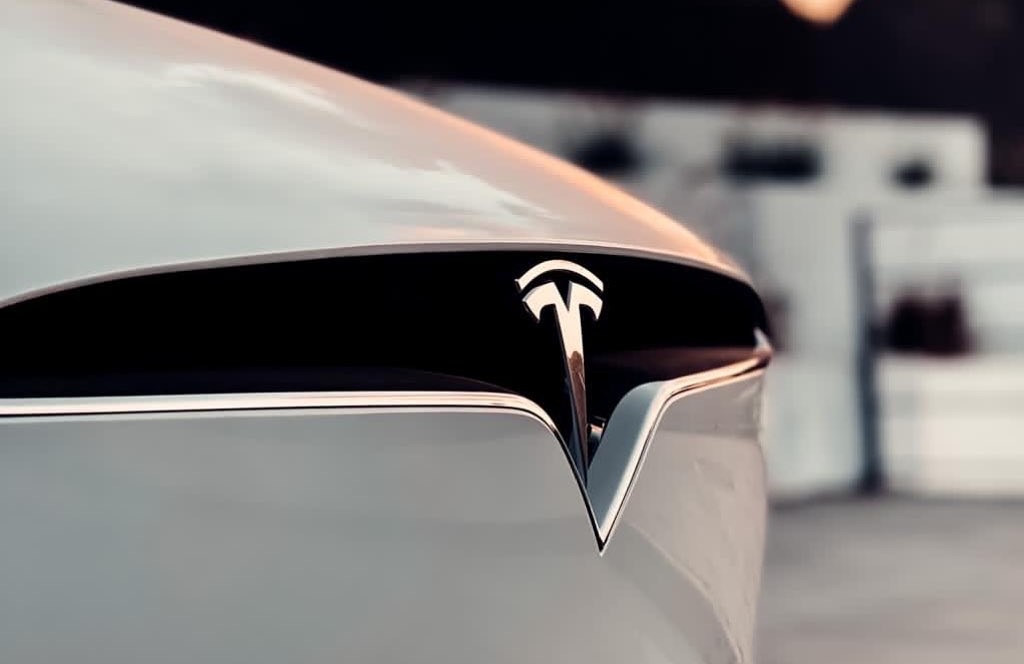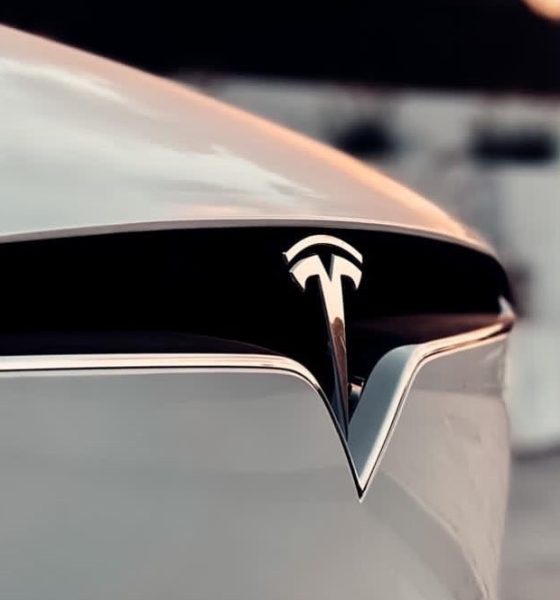

Investor's Corner
Top Wall St analyst sees Tesla’s (TSLA) trillion-dollar potential, raises $1.2k price target
Piper Sandler analyst Alexander Potter, a top-ranked Wall Street analyst, has raised his price target for Tesla stock (NASDAQ:TSLA) to a “Street High” of $1,200 per share, up from his previous estimate of $515 per share. Potter also maintained his “Overweight” rating for the stock.
In an extensive research note that spanned over a hundred pages, Potter outlined Tesla’s potential, highlighting that the electric car maker is taking on trillion-dollar industries. What is rather remarkable is that despite Piper Sandler’s undoubtedly optimistic stance on TSLA stock, the firm’s estimates are still conservative relative to the electric car maker’s self-imposed targets.
“Some may scoff at our generous assumptions re: TSLA’s long-term potential, but consider this: our model does not contemplate Tesla’s eventual entry into the HVAC or auto insurance markets, both of which represent hundreds of billions in market-wide revenue. Our forecast of peak vehicle production (9M units/year) is also materially below Tesla’s own ambitions, based on capacity plans outlined at Battery Day. Plus we could be under-modeling Tesla’s solar revenue, as well as “Autobidder” and other opportunities in the Energy segment (these businesses are still nascent),” Potter wrote in his research.
Interestingly enough, Piper Sandler’s research covered and acknowledged Tesla’s multiple businesses and opportunities, such as its energy and battery projects. This is rather remarkable considering that Wall Street, for the most part, has largely ignored Tesla’s efforts save for its electric car business. The analyst even mentioned the value of Tesla’s strong brand, which needs no ads to capture the market’s attention. More importantly, the firm also recognized that Tesla’s momentum may very well result in the EV maker seeing sustained success.
“Our forecast implies 894k vehicle deliveries in 2021, eventually ramping to 9M+ units in 2030. Note that this level of production would rank TSLA among the top-3 auto makers globally. More important still, we anticipate a steady ramp in full self-driving (FSD) software adoption starting in 2030, with 50%+ of all Tesla owners using the FSD package by the end of our forecast period. This should have a big impact on margins, with EBIT margin eventually exceeding 40%. Finally, by the 2030s, we expect Tesla Energy to represent 20%-30% of revenue (vs. ~6% today). Taken together, these changes drive our DCF-based price target up to $1,200 (vs. $515 previously),” the analyst wrote.
Ultimately, the Piper Sandler analyst noted that while Tesla’s 2020 was one for the books, the “fireworks” for the company are nowhere near over. “2020 was a breakout year for TSLA, but in our view, the fireworks aren’t over. Even after a 10x return over the past 12 months, we don’t think investors should be selling this stock,” Potter wrote.
Disclaimer: I am long TSLA.
Don’t hesitate to contact us for news tips. Just send a message to tips@teslarati.com to give us a heads up.

Investor's Corner
Tesla stock closes at all-time high on heels of Robotaxi progress

Tesla stock (NASDAQ: TSLA) closed at an all-time high on Tuesday, jumping over 3 percent during the day and finishing at $489.88.
The price beats the previous record close, which was $479.86.
Shares have had a crazy year, dipping more than 40 percent from the start of the year. The stock then started to recover once again around late April, when its price started to climb back up from the low $200 level.
This week, Tesla started to climb toward its highest levels ever, as it was revealed on Sunday that the company was testing driverless Robotaxis in Austin. The spike in value pushed the company’s valuation to $1.63 trillion.
Tesla Robotaxi goes driverless as Musk confirms Safety Monitor removal testing
It is the seventh-most valuable company on the market currently, trailing Nvidia, Apple, Alphabet (Google), Microsoft, Amazon, and Meta.
Shares closed up $14.57 today, up over 3 percent.
The stock has gone through a lot this year, as previously mentioned. Shares tumbled in Q1 due to CEO Elon Musk’s involvement with the Department of Government Efficiency (DOGE), which pulled his attention away from his companies and left a major overhang on their valuations.
However, things started to rebound halfway through the year, and as the government started to phase out the $7,500 tax credit, demand spiked as consumers tried to take advantage of it.
Q3 deliveries were the highest in company history, and Tesla responded to the loss of the tax credit with the launch of the Model 3 and Model Y Standard.
Additionally, analysts have announced high expectations this week for the company on Wall Street as Robotaxi continues to be the focus. With autonomy within Tesla’s sights, things are moving in the direction of Robotaxi being a major catalyst for growth on the Street in the coming year.
Elon Musk
Tesla needs to come through on this one Robotaxi metric, analyst says
“We think the key focus from here will be how fast Tesla can scale driverless operations (including if Tesla’s approach to software/hardware allows it to scale significantly faster than competitors, as the company has argued), and on profitability.”

Tesla needs to come through on this one Robotaxi metric, Mark Delaney of Goldman Sachs says.
Tesla is in the process of rolling out its Robotaxi platform to areas outside of Austin and the California Bay Area. It has plans to launch in five additional cities, including Houston, Dallas, Miami, Las Vegas, and Phoenix.
However, the company’s expansion is not what the focus needs to be, according to Delaney. It’s the speed of deployment.
The analyst said:
“We think the key focus from here will be how fast Tesla can scale driverless operations (including if Tesla’s approach to software/hardware allows it to scale significantly faster than competitors, as the company has argued), and on profitability.”
Profitability will come as the Robotaxi fleet expands. Making that money will be dependent on when Tesla can initiate rides in more areas, giving more customers access to the program.
There are some additional things that the company needs to make happen ahead of the major Robotaxi expansion, one of those things is launching driverless rides in Austin, the first city in which it launched the program.
This week, Tesla started testing driverless Robotaxi rides in Austin, as two different Model Y units were spotted with no occupants, a huge step in the company’s plans for the ride-sharing platform.
Tesla Robotaxi goes driverless as Musk confirms Safety Monitor removal testing
CEO Elon Musk has been hoping to remove Safety Monitors from Robotaxis in Austin for several months, first mentioning the plan to have them out by the end of 2025 in September. He confirmed on Sunday that Tesla had officially removed vehicle occupants and started testing truly unsupervised rides.
Although Safety Monitors in Austin have been sitting in the passenger’s seat, they have still had the ability to override things in case of an emergency. After all, the ultimate goal was safety and avoiding any accidents or injuries.
Goldman Sachs reiterated its ‘Neutral’ rating and its $400 price target. Delaney said, “Tesla is making progress with its autonomous technology,” and recent developments make it evident that this is true.
Investor's Corner
Tesla gets bold Robotaxi prediction from Wall Street firm
Last week, Andrew Percoco took over Tesla analysis for Morgan Stanley from Adam Jonas, who covered the stock for years. Percoco seems to be less optimistic and bullish on Tesla shares, while still being fair and balanced in his analysis.

Tesla (NASDAQ: TSLA) received a bold Robotaxi prediction from Morgan Stanley, which anticipates a dramatic increase in the size of the company’s autonomous ride-hailing suite in the coming years.
Last week, Andrew Percoco took over Tesla analysis for Morgan Stanley from Adam Jonas, who covered the stock for years. Percoco seems to be less optimistic and bullish on Tesla shares, while still being fair and balanced in his analysis.
Percoco dug into the Robotaxi fleet and its expansion in the coming years in his latest note, released on Tuesday. The firm expects Tesla to increase the Robotaxi fleet size to 1,000 vehicles in 2026. However, that’s small-scale compared to what they expect from Tesla in a decade.
Tesla expands Robotaxi app access once again, this time on a global scale
By 2035, Morgan Stanley believes there will be one million Robotaxis on the road across multiple cities, a major jump and a considerable fleet size. We assume this means the fleet of vehicles Tesla will operate internally, and not including passenger-owned vehicles that could be added through software updates.
He also listed three specific catalysts that investors should pay attention to, as these will represent the company being on track to achieve its Robotaxi dreams:
- Opening Robotaxi to the public without a Safety Monitor. Timing is unclear, but it appears that Tesla is getting closer by the day.
- Improvement in safety metrics without the Safety Monitor. Tesla’s ability to improve its safety metrics as it scales miles driven without the Safety Monitor is imperative as it looks to scale in new states and cities in 2026.
- Cybercab start of production, targeted for April 2026. Tesla’s Cybercab is a purpose-built vehicle (no steering wheel or pedals, only two seats) that is expected to be produced through its state-of-the-art unboxed manufacturing process, offering further cost reductions and thus accelerating adoption over time.
Robotaxi stands to be one of Tesla’s most significant revenue contributors, especially as the company plans to continue expanding its ride-hailing service across the world in the coming years.
Its current deployment strategy is controlled and conservative to avoid any drastic and potentially program-ruining incidents.
So far, the program, which is active in Austin and the California Bay Area, has been widely successful.








